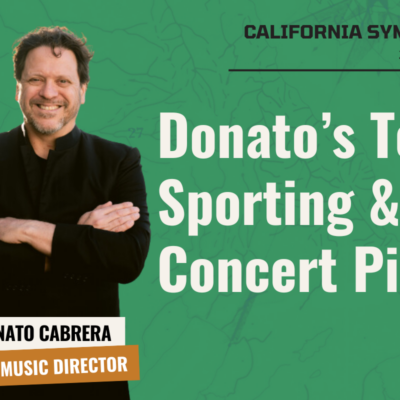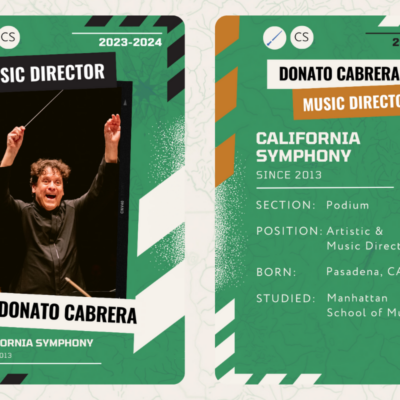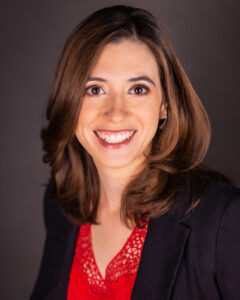
Executive Director Lisa Dell
It’s been called “a model for residency programs across the country” (Mercury News).
Not all orchestras around the country have resident composer programs, and among those that exist, the California Symphony’s Young American Composer-in-Residence program is different in three key ways, says California Symphony Executive Director Lisa Dell.
1. Real relationships take time
Several orchestras across the country have resident composer programs and most often they will partner with a composer to commission a single work, or maybe they’ll work together over a couple of years. One of the most important and unique aspects of the California Symphony’s residency is that it’s a three year program, and the composer delivers three compositions during that time. That gives the resident composer a chance to develop real relationships with the musicians, with [Music Director] Donato, and with the organization, as well as giving tremendously useful insights into how an orchestra functions.
Composer-in-Residence Katherine Balch (2017-2020) agrees. “So often when you work with an orchestra as a composer, it’s just one or two rehearsals, then the show, and you’re done interacting with that organization. But what the California Symphony does, is it gives a chance to a young artist to invest in and be invested in by a community. To me this type of synergy and opportunity for dialogue is what makes the artistic process more meaningful for everyone.” She adds, “It’s wonderful, not only because I know I get to write three pieces for this incredible ensemble, but also because I have time to establish an actual human connection with the people in it.”
By providing three consecutive years for a composer to really build a relationship and a rapport with the orchestra, administration and musicians, it allows a level of development that’s really unique.”—Dan Visconti (Composer-in-Residence 2014-17; Berlin Prize 2008; Rome Prize 2013)
2. Community engagement
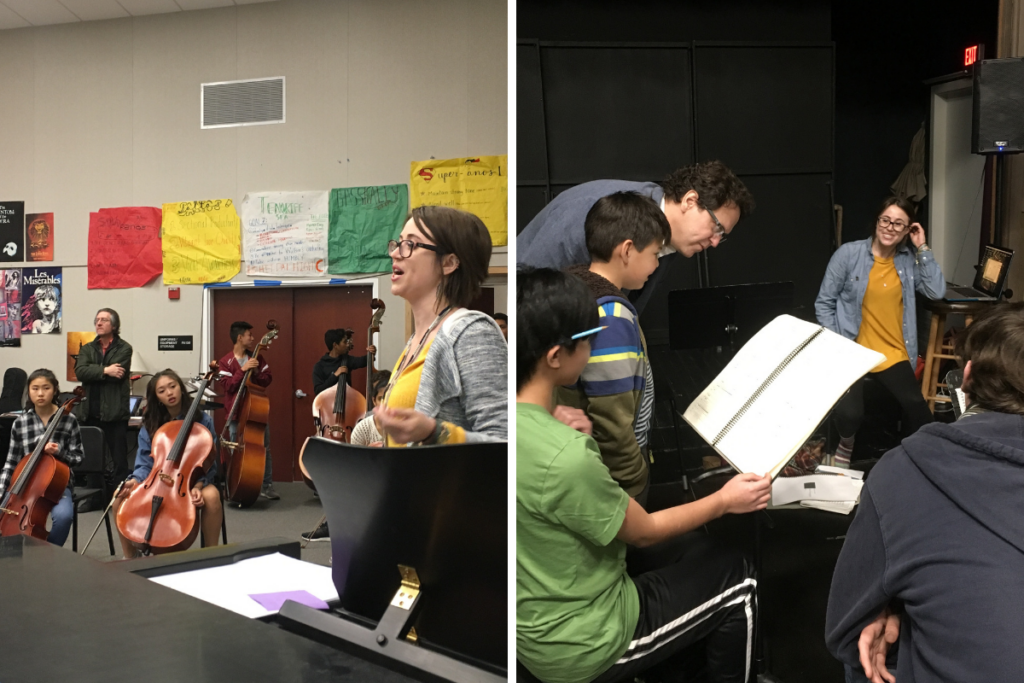
Katherine Balch at Dougherty Valley High School in San Ramon (left) and with Music Director Donato Cabrera at the Crowden Music Center in Berkeley (right).
During the course of three years, much of the relationship with California Symphony staff is conducted by mail, phone and Skype calls, but in the run up to the workshop and the premiere, the composer will usually stay in Walnut Creek for up to a week at a time. Again, the fact that the composer gets to return several times over the course of their three-year residency makes for greater continuity and more meaningful interactions with the community.
While in town, the resident composer has a full schedule that often includes media interviews, donor events, rehearsals, talks, and visits to local schools, including to the students of Sound Minds, the California Symphony’s flagship music education program for at-risk children in the Bay Area.
Katherine’s visits to the Sound Minds kids are rewarding for both sides. During the course of their intensive music studies, students learn about composers like Beethoven and Tchaikovsky, and they also play music by living composers. When students have the chance to talk with someone like Katherine, they begin to see new possibilities and some have even been inspired to dabble in composition themselves.
Everyone is so friendly and smart and has an energized, positive attitude. With the California Symphony, there is a real sense of taking the time to cultivate a sense of community and reflect on the music making.”—Katherine Balch
3. A testing ground for new ideas
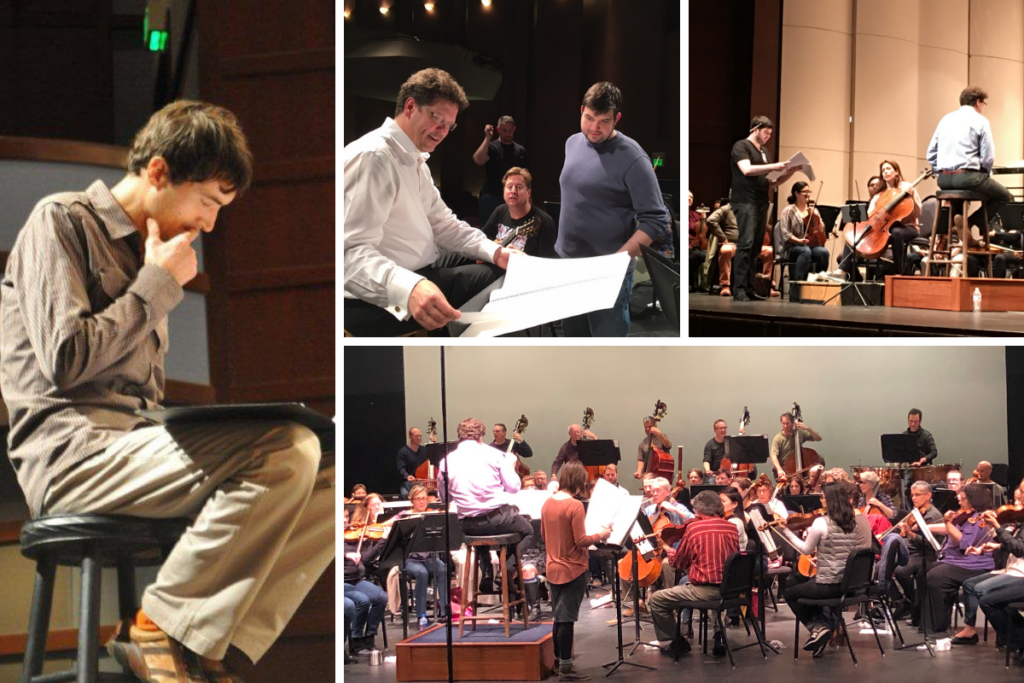
Working with the orchestra, clockwise from left to right: Mason Bates (2007-2010); Dan Visconti (2014-2017) at the workshop reading and in final rehearsal; Katherine Balch (2017-2020).
We hope that we can just provide a platform of dreaming, without restriction, for the composer, in terms of what to write next.”—Music Director Donato Cabrera
Probably the most unique thing about our residency program is that the composer gets to workshop the music with the full orchestra in a 30-minute rehearsal that takes place months ahead of the performance.
For composer Katherine Balch, her first workshop with the orchestra was illuminating. She had come to the rehearsal reading with what she thought was a finished score, however hearing it played back by the orchestra, she realized there were a lot of parts she wanted to revise and edit.
Katherine says: “I made a ton of changes. I was so surprised how helpful and informative a half-hour of reading could be. Listening back to the recording helped me make a million tiny adjustments to the score (dynamics, balance, doublings, simplifying) and also some larger ones (I changed the end and added about a minute of music). I am so grateful to the orchestra for helping me make this a better piece! It’s such an unusual experience to get the chance to make revisions before a premiere performance like that.”
For her second year commission, working on Artifacts—a violin concerto that received its world premiere at the 2019 May season finale—Katherine took a very different approach to using her time with the orchestra. This time around, she came wanting to try out a few different ideas, including using the violins in a non-traditional way to create the sound textures she was looking for. These aren’t sounds that are readily available in computer composition programs, so having the time with the orchestra enabled her to find out if her ideas could really translate in a live orchestra performance.
What’s Next?
Viet’s next commission will be premiered with the California Symphony at 2022/23 season finale FRESH INSPIRATIONS on May 20 and 21, and the search for the next resident composer is underway, with applications for the 2023-26 cycle due by Monday, October 17. What’s more, Viet will play an important part in the selection process.
For the 2017-20 composer search, the applicant pool increased by more than 75% and female applicants rose by 20%. Changes were made to the review process as part of our commitment to diversity and inclusion, making the submission process simpler (everything was submitted digitally, rather than requiring costly printed score submissions) and mimicking the blind audition process already in place for musicians by requiring candidates to redact any reference to sex or race.
We are encouraged by the outcomes of the two composer searches since then. In 2017, Katherine Balch became our first woman composer and in 2020, Viet became our first composer of color.
Who will be next? We can’t wait to find out.
In their own words
It really changed my life. It was such an exciting moment, to have this opportunity to write three works which were rehearsed and tried out even before the week of premiere.”—Kevin Puts (Composer-in-Residence 1996-1999; Rome Prize 2002; Pulitzer Prize for Music 2012)
The skills not only in working with musicians in the California Symphony but also in working with the community have been really important things that I’ve learned in those three critical years at the California Symphony.”—Mason Bates (Composer-in-Residence 2007-2010; Rome Prize 2004; Kennedy Center Composer-in-Residence 2015)
Here’s what California Symphony composers-in-residence have to say about their experience with us.
You can support the Young American Composer-in-Residence program and other music education and community engagement initiatives, making a difference in the lives of thousands of people in the Bay Area. Donate online or call the office at 925.280.2490 for assistance.



